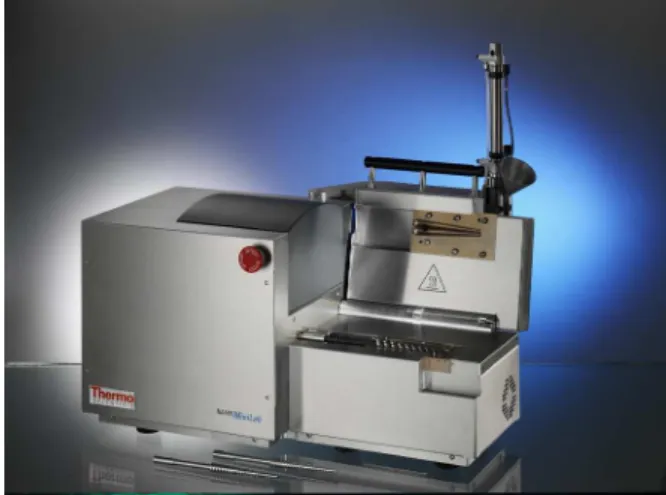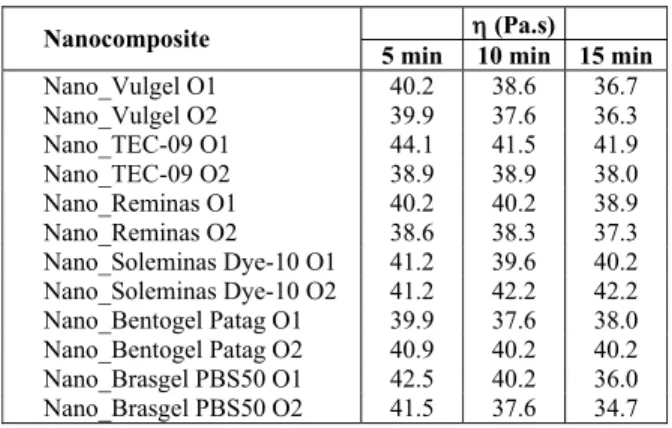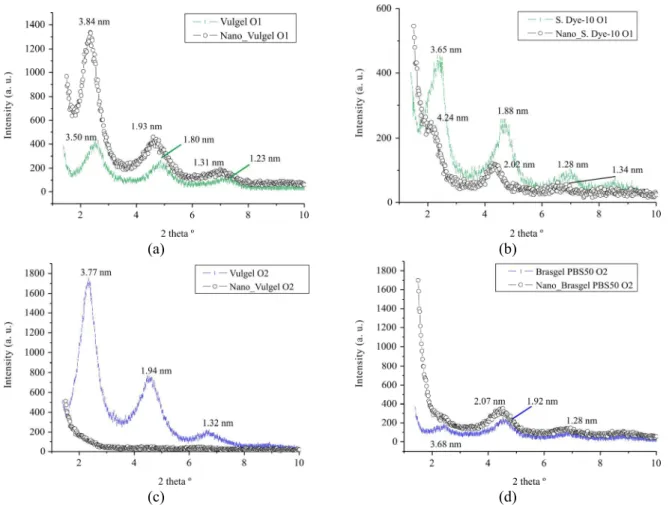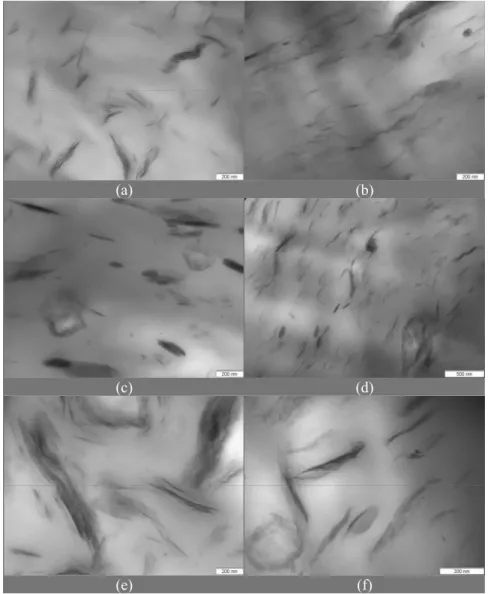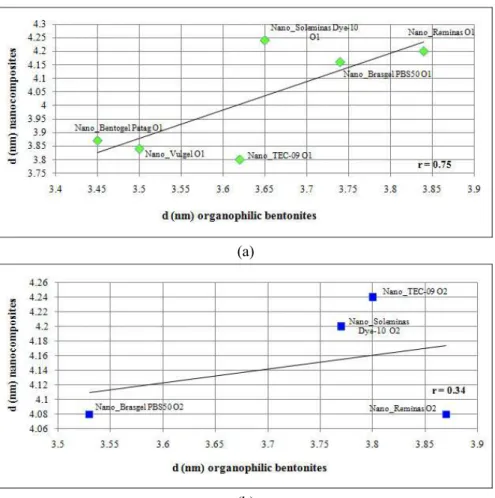ISSN 0104-6632 Printed in Brazil
www.abeq.org.br/bjche
Vol. 29, No. 04, pp. 751 - 762, October - December, 2012
Brazilian Journal
of Chemical
Engineering
ORGANOPHILIC BENTONITES BASED ON
ARGENTINEAN AND BRAZILIAN BENTONITES.
PART 2: POTENTIAL EVALUATION TO OBTAIN
NANOCOMPOSITES
L. B. Paiva
1*, A. R. Morales
1, M. C. Branciforti
2and R. E. S. Bretas
21
School of Chemical Engineering, State University of Campinas, UNICAMP, Phone: + (55) (19) 3521-3907, P.O. Box 6066, CEP: 13083-970, Campinas - SP, Brazil.
*E-mail: lucilenebetega@yahoo.com.br, morales@feq.unicamp.br 2
Department of Materials Engineering, Federal University of São Carlos, Rodovia Washington Luis, Km 235, P.O. Box 676, CEP: 13565-905, São Carlos - SP, Brazil.
(Submitted: June 23, 2011 ; Revised: December 20, 2011 ; Accepted: February 15, 2012)
Abstract - This work describes the preparation of composites of polypropylene and organophilic bentonites based on Brazilian and Argentinean bentonites. During the processing of the samples in a twin screw microextruder, torque and pressures of the extruder were accompanied and the viscosity values were calculated. No significant changes in the torque, pressure and viscosity were found for composites prepared with different bentonites. The samples were characterized by XRD and TEM to evaluate the structure and dispersion of the organophilic bentonites. Composites with exfoliated, partially exfoliated and intercalated structures were obtained and correlations between the intrinsic properties of the sodium clays and organophilic bentonites and their influence on the composites were studied. The cation exchange capacity of the sodium bentonites and the swelling capacity of the organophilic bentonites were the most important properties to obtain exfoliated structures in composites. All bentonites showed the potential to obtain polymer nanocomposites, but the ones from Argentina displayed the best results.
Keywords: Bentonite; Polypropylene; Nanocomposite.
INTRODUCTION
Polymeric nanocomposites are a class of materials composed of one reinforcing agent with at least one dimension on the nanometric scale, dispersed in a polymer matrix within the nanometer range (Alexandre and Dubois, 2000; Beyer, 2002). The main applications of nanocomposites include the automotive and packaging areas, but also applications in other areas such as aerospace, electronic and biotechnological areas are important (Meenakshi
et al., 2011; Nguyen, 2011; Armentano et al., 2010;
Schmidt et al., 2002; Gorrassi et al., 2003; Luo and Daniel, 2003).
Kaspersma et al. (2002), Gorrassi et al. (2003), Kim
et al. (2004), Ramos Filho et al. (2005), Nogueira
et al. (2005), Zhang et al. (2006), Picard et al.
(2007), Muksing et al. (2008), Sharma and Nayak (2009) and Morales et al. (2010), among others, can be mentioned. This method also allows nanocomposites to be formulated directly by using conventional compounding devices like extruders or mixers. Another important aspect is that the technique does not require the use of solvents, which makes it adequate from the environmental and industrial points of view (Alexandre and Dubois, 2000; Beyer, 2002; Zhu et al., 2002; Pavlidou and Papaspyrides, 2008). If the organophilic clay and the polymer are compatible, the polymer chains can migrate to the interlayer space of the clay to form a nanocomposite. The different levels of dispersion of the organophilic clay in the polymeric matrix can result in three structures: micro-composites in which the clay is not nano-dispersed; intercalated structures, in which single or more polymer chains are intercalated between the clay layers, resulting in an ordered multilayer structure of alternating polymeric and inorganic layers; and an exfoliated structure in which the clay layers are completely and uniformly dispersed in the continuous polymer matrix (Paiva
et al., 2007).
Aspects related to the influence of intrinsic properties of the pristine clays in nanocomposites are scarce in the literature; some correlations were found only in the works of Delbem (2005) and Chavarria
et al. (2007). In our previous work (Paiva and Morales,
2012) the intrinsic properties of sodium bentonites were evaluated and correlated with their organo-philization capacity. This work evaluates composites produced from these organophilic bentonites, which were modified by two different methodologies: in aqueous dispersion and semisolid medium. Correla-tions between the intrinsic properties of the organo-clays and the composites properties were also established.
EXPERIMENTAL
Materials
The materials used to prepare the nanocomposites were the six bentonites modified by the two methodologies described in our previous work, Part 1 (Vulgel, TEC-09, Reminas, Soleminas Dye-10, Bentogel Patag and Brasgel PBS 50, designed as O1 for modification in aqueous dispersion, and O2 for modification in semisolid medium), the polypropylene
matrix (PP) [XM6150K from Quattor, MFI of 35g/10 min and density of 0.905 g/cm3] and the coupling agent polypropylene grafted with maleic anhydride [(PP-g-MA) Orevac CA100 from Atofina, MFI of 150-200 g/10 min and a high amount of maleic anhydride (the supplier did not inform the exact content)].
Preparation of Composites
The composites of PP/organobentonite were prepared through melt intercalation. The total com-position was 80 wt% of PP, 15 wt % of PP-g-MA and 5 wt % of organobentonite. This mixture was processed in a twin screw HAAKE MiniLab II microextruder from Thermo Fischer Scientific, Figure 1. All mixtures were processed for 15 min after polymer melting. The screws operated in a co-rotating way at 100 rpm and the temperature of processing was 180 ºC. Torque as well as entrance and exit pressures of the extruder were monitored. The samples were designated as Nano following the name of the respective organobentonite, for example, Nano_Vulgel O1.
Figure 1: HAAKE MiniLab II Microextruder.
Characterization Techniques
The dispersion of the organobentonites in the PP matrix and the structures formed were also evaluated by transmission electronic microscopy. Samples 50 nm in thickness were produced in a Leica model Reichert Ultracut FC4 microtome. Analyses were carried out on a Philips model CM120 microscope at 120 kV.
RESULTS AND DISCUSSION
An example of the visual aspect of the extruded samples can be seen in Figure 2. All samples showed translucence and brown coloration characteristic of the bentonite. No agglomerate particles of clay were observed. The translucency and brown coloration were also observed in our previous work (Paiva, 2007), for nanocomposites with the same matrix and compatibilizing agent and the commercial organo-philic clay Cloisite® 20A.
Figure 2: Example of a sample of nanocomposite prepared in the microextruder (Nano_Vulgel O2).
Evaluation of the Viscosity During Processing of the Nanocomposites
The torque and pressure inside the microextruder were monitored during the whole process. They were measured at three processing times: five, ten and fifteen min. From these results the viscosity values were calculated using the equipment software.
The viscosities of the composites were very similar, as shown in Table 1. There is a tendency for viscosity reduction during processing. This behavior has already been observed and can be explained by the alignment of the clay due the shear (Tang et al., 2010; Durmuş et al., 2007; Százdi et al., 2007; Ali Dadfar et al., 2011). It was more evident for Nano_Vulgel O1, Nano_Vulgel O2, Nano_TEC-09 O1, Nano_Brasgel PBS50 O1 and Nano_Brasgel PBS50 O2. Although not studied in this work, differences in the aspect ratio could be the cause for
those differences between the samples, since the clay treatment, polymer matrix and processing conditions were kept unchanged.
Table 1: Viscosity of the samples during processing.
η (Pa.s) Nanocomposite
5 min 10 min 15 min Nano_Vulgel O1 40.2 38.6 36.7 Nano_Vulgel O2 39.9 37.6 36.3 Nano_TEC-09 O1 44.1 41.5 41.9 Nano_TEC-09 O2 38.9 38.9 38.0 Nano_Reminas O1 40.2 40.2 38.9 Nano_Reminas O2 38.6 38.3 37.3 Nano_Soleminas Dye-10 O1 41.2 39.6 40.2 Nano_Soleminas Dye-10 O2 41.2 42.2 42.2 Nano_Bentogel Patag O1 39.9 37.6 38.0 Nano_Bentogel Patag O2 40.9 40.2 40.2 Nano_Brasgel PBS50 O1 42.5 40.2 36.0 Nano_Brasgel PBS50 O2 41.5 37.6 34.7
Among all composites, the highest viscosity was 44.1 Pa.s for Nano_TEC-09 O1 after five min of processing, while the lowest was 34.7 Pa.s for Nano_Brasgel PBS50 O2 after fifteen min of processing. These values show that all organophilic bentonites can be processed under the same conditions; the data were not compared with other data from literature because similar studies were not found.
Evaluation of the Nanocomposite Structures by X-Ray Diffraction
(a) (b)
(c) (d) Figure 3: X-ray diffraction patterns of organophilic bentonites (a) Vulgel O1, (b) Soleminas Dye-10 O1,
(c) Vulgel O2 and (d) Brasgel PBS50 O2 and their respective nanocomposites.
Table 2: Basal spacings of the (001) reflections of organo-philic bentonites and their respective nanocomposites.
Bentonite/nancomposite d(nm)
Vulgel O1 3.50
Nano_Vulgel O1 3.84
Vulgel O2 3.77
Nano_Vulgel O2 -
TEC-09 O1 3.62
Nano_TEC-09 O1 3.80
TEC-09 O2 3.80
Nano_TEC-09 O2 4.24
Reminas O1 3.84
Nano_Reminas O1 4.20
Reminas O2 3.87
Nano_Reminas O2 4.08
Among the composites prepared with the organophilic bentonites modified in aqueous dispersion, the samples Nano_Vulgel O1, Nano_TEC-09 O1, Nano_Reminas O1 e Nano_Brasgel O1 showed X-ray diffraction patterns similar to the organophilic bentonites, but with larger basal spacings. This suggests that intercalation of the polymer chains occurred, but the clay structure was preserved. The possibility of partial exfoliation exists, but only the structurally ordered fraction is detected by this technique. The sample Nano_Soleminas Dye-10 O1 did not show a well-defined diffraction peak in the region of 2θ= 2º, but instead a “shoulder” at 2.08º was observed that corresponds to a basal spacing of 4.24 nm, while in the organophilic bentonite the diffraction angle was 2.42º and the basal spacing was 3.65 nm. The same behavior was observed for Nano_Brasgel PBS50 O1, which showed a basal spacing of 4.16 nm. The results suggest that structures with some degree of disorder were obtained, but it is possible that partially intercalated and exfoliated structures occurred. For the composites from organophilic bentonites modified in aqueous dispersion, considering the main diffraction peak, the highest basal spacing was obtained for Nano_Soleminas Dye-10 O1, 4.24 nm, while the lowest was for Nano_TEC-09 O1, 3.80 nm. Among the composites from the organophilic bentonites modified in semisolid medium, disappearance of all diffraction peaks occurred for the Nano_Vulgel O2, which is a strong indication that an exfoliated structure was formed. The composites Nano_TEC-09 O2, Nano_Reminas O2, Nano_Soleminas Dye-10 O2 and Nano_Bentogel Patag O2 also did not show well-defined diffraction peaks in the region of 2θ= 2º as observed in the respective organophilic bentonite. The results again suggest the formation of structures with some degree of disorder with the possibility of the existence of partially intercalated and exfoliated structures. Nano_Brasgel PBS50 O2 did not show a diffraction peak in the region of 2θ = 2º which suggest that the bentonite was partially exfoliated. For the composites prepared with the organophilic bentonites modified in semisolid medium, the highest basal spacing was for Nano_TEC-09 O2, 4.24 nm, and the lowest was for Nano_Reminas O2 and Nano_Bentogel Patag O2, 4.08 nm (slightly lower, but not a significant difference). The two hypotheses discussed for the occurrence of the three diffraction peaks in the organophilic bentonites (previously discussed in Part 1 of this work) can be considered for the composites. The first hypothesis is based on the existence of different levels of intercalation of organic cations between the clay
in the structures. This is one more indication of the efficiency of modification of bentonites by semisolid methodology and show that the bentonites modified by this method can be employed to obtain polymer nanocomposites. The potential to obtain nano-composites with the studied bentonites is another aspect to be considered.
Evaluation of the Dispersion of Organophilic Bentonites in PP by Transmission Electronic Microscopy
To complete the characterization of the composites; TEM micrographs are presented in Figures 4 and 5. In the micrographs, dark regions with lamellar form with different thicknesses
attributed to the organophilic clay phase can be observed. The thinner regions suggest the presence of individual layers or tactoids with few layers of clay minerals, while the thicker ones must be agglomerates of clay particles or even impurities. The TEM micrographs show that dispersion of the clays occurred in all samples, but at different levels. It is possible to observe the existence of different phases. Different levels of basal spacings were observed by X-ray analysis and some exfoliation should be expected. A limitation of this analysis is that the observation field of TEM is small and the interpretation must be careful. In order to interpret the results, a classificatory scale was used, which takes into account the observed aspects, as explained in the next paragraphs.
(a) (b)
(c) (d)
(e) (f)
(a) (b)
(c) (d)
(e) (f)
Figure 5: TEM micrographs: (a) Nano_Vulgel O2, (b) Nano_TEC-09 O2, (c) Nano_Reminas O2, (d) Nano_Soleminas Dye-10 O2, (e) Nano_Bentogel Patag O2, (f) Nano_Brasgel PBS50 O2.
Class 10
Predominance of a dispersed phase with flexible layers highly spread in all extension, with clear color. Absence of non-dispersed particles, agglomerates or impurities. Good dispersion with predominance of exfoliation - Sample: Nano_Vulgel O2
Class 8
Existence of mixture:
1. Dispersed phases with the characteristic of flexible layers highly spread in all the extension, with clear color;
2. Dispersed phases with stacked layers and dark color. Presence of non-dispersed particles, absence of agglomerates or impurities. Good dispersion with a mixture of intercalation and exfoliation - Samples:
Nano_Vulgel O1, Nano_Bentogel Patag O1 and Nano_Bentogel Patag O2.
Class 6
Presence of non-dispersed and dark particles, agglomerates or impurities, with a morphology as described in Class 10. Medium dispersion with partial intercalation and exfoliation, non-intercalated particles or impurities - Samples: Nano_TEC-09 O1 and Nano_ TEC-09 O2.
Class 4
Nano_Soleminas 10 O1, Nano_Soleminas Dye-10 O2, Nano_Brasgel PBS50 O1 and Nano_Brasgel PBS50 O2.
Class 2
Presence of many dark particles, agglomerates or impurities, with a morphology as described in Class 4. Very low dispersion, intercalation, and non-intercalated particles or impurities - Samples: Nano_ Reminas O1 and Nano_Reminas O2.
In some cases, regions with fractions of clay of round or ellipsoidal shapes with a clear aspect in the center with intercalated/exfoliated appearance can be observed. This characteristic can be associated with particles of organobentonite that opened but were not totally dispersed due to an insufficient shear; or can be fractions of organophilic bentonite near the polar regions of the maleic anhydride used as the coupling agent.
The results showed that there is not a well-defined and unique structure, but a distribution of phases, where intercalated, exfoliated and agglomerate regions co-exist. However, there is the presence of fractions with a good separation of the layers of the organophilic clay, mainly for organophilic bentonites from the Argentinian sodium bentonites, Vulgel O1, Vulgel O2, Bentogel Patag O1 and Bentogel Patag O2.
The existence of intercalated, exfoliated and agglomerate phases in nanocomposites was also observed by Chow et al. (2005) for polyamide-6/PP and organophilic clay nanocomposites.
Hedayati and Arefazar (2009) evaluated the dispersion of commercial organophilic clay modified with similar quaternary ammonium salts in a PP-g-MA matrix and also observed a non-uniform dispersion of the clay in the matrix, besides some indistinct tactoids. The micrographs also showed intercalated and partially exfoliated phases.
It is not possible to make a precise identification of the structures only by the TEM or XRD techniques, because the techniques are different. While TEM allows the observation of different phases and also some impurities and particles shape, XRD allows an evaluation of the basal spacing between layers of the clay. For this reason, the results of both techniques are complementary. As an example, the analyses made with Nano_Vulgel O1 where the diffraction peaks showed an intercalated structure can be mentioned; however, the micrograph showed an intercalated and exfoliated structure. For Nano_Vulgel O2, the XRD analysis showed an exfoliated structure that was confirmed by TEM. In conclusion, compared to other results found in the literature, similar microstructures for nanocomposites with exfoliated, partially exfoliated and intercalated and intercalated structures were obtained.
Properties Correlation
In this section, some correlations between the properties of sodium or organophilic bentonites and the properties of composites are presented. The purpose is to complement the correlations of properties presented in Part 1 of this work and to finish the evaluation of the potential use of bentonites to obtain polymer nanocomposites.
The results showed that there is a strong tendency of sodium bentonites with higher cation exchange capacity (CEC) in the organophilic form to better disperse in the polymer matrix. This can be observed in the sodium bentonites Vulgel S and Bentogel Patag S; they had the higher CEC and their respective composites had the better classification as evaluated by TEM. The bentonite Reminas S had the lowest CEC and the respective composites showed the worst classification by TEM. This correlation is shown in Figure 6. The higher CEC conferred better organophilic characteristics on the bentonites and thus promoted a better dispersion of the bentonites in the composites. Chavarria et al. (2007) also observed that lower values of the CEC resulted in a low degree of exfoliation of organophilic clays in nano-composites with polyamide-6 and PP/ PP-g-MA.
In Figures 7(a) and 7(b) the influence of basal spacing of the organophilic clays on the basal spacing of composites can be analyzed. There is a dependency, which can be considered partial, of a higher basal spacing of organophilic bentonites leading to a higher basal spacing of the composites, considering the intercalated phases. All samples prepared with bentonites modified in aqueous dispersion showed a (001) reflection; however, among the samples prepared with the bentonites modified in semisolid medium, Nano_Vulgel O2 did not show any basal reflection. Besides, this composite was not derived from the organophilic bentonite with the highest basal spacing, but resulted in an exfoliated structure. This indicates that a good intercalation or exfoliation does not necessarily occur for organophilic clays with high basal spacing. A similar behavior was observed for Nano_Brasgel PBS50, in which the main basal reflection disappeared, but did not show the highest basal spacing. Delbem (2005) also observed that the high basal spacing in organophilic clays is not the main parameter that contributes to the formation of intercalated or exfoliated structures.
Figure 6: CEC of sodium bentonites versus TEM class micrographs.
(a)
(b)
(a)
(b)
Figure 8: Swelling capacity in xylene (after stirring and standing 24 h) of organophilic bentonites versus TEM class micrographs of their respective nanocomposites: (a) organophilic clays O1 (modified in aqueous dispersion); (b) organophilic clays O2 (modified in semi-solid medium).
In all curves the correlation coefficient, r, is presented. Except for the correlation between basal spacing of organophilic bentonites and the basal spacing of the composites, Figure 7, the values of r indicate moderate to strong correlation.
Based on these analyses, it was observed that for nanocomposites obtained from organically modified bentonites the structures of the nanocomposites were strongly dependent on several properties of the sodium bentonites. Among these properties, swelling capacity in water and cation exchange capacity (CEC) were the most significant. In summary, higher swelling capacities and higher CEC produce organophilic bentonites with more pronounced organophilic characteristics which in turn contribute to a better dispersion of the bentonites in the PP matrix.
CONCLUSION
The organophilic bentonites studied showed good performance in the preparation of the composites. The composites showed exfoliated, partially exfoliated and intercalated, and intercalated structures, depending on the bentonite grade. The results were similar to those found in other works in the recent literature, which show that the systems obtained are promising.
ACKNOWLEDGMENTS
The authors would like to thanks CNPq and FAPESP for financial support of this project, the companies Flow Chemical, Ioto International, J. Reminas, Bentonit União do Nordeste and Bentonisa, who supplied the bentonites, Clariant SA., who supplied quaternary ammonium salt Praepagen WB Bentonisa, and Dr. Hans M. Petri and Dr. Dirk Hauch from Thermo Fischer Scientific for the support in the preparation of the nanocomposites samples. The author M.C. Branciforti thanks Dr. I. Lieberwirth from MPI for Polymer Research and DAAD for the microtome donation.
REFERENCES
Alexandre, M., Dubois, P., Polymer-layered silicate nanocomposites: Preparation, properties and uses of a new class of materials. Mat. Sci. Eng. R., 28, 1-63 (2000).
Ali Dadfar, S. M., I. Alemzadeh, I., Reza Dadfar, S. M., Vosoughi, M., Studies on the oxygen barrier and mechanical properties of low density polyethylene/organoclay nanocomposite films in the presence of ethylene vinyl acetate copolymer as a new type of compatibilizer. Mat. and Design, 32, 4, 1806-1813 (2011).
Armentano, I., Dottori, M., Fortunnati, E., Mattiolli, S., Kenny, J. M., Biodegradable polymer matrix nanocomposites for tissue engineering: A review. Pol. Degrad. and Stab., 95, 11, 2126-2146 (2010). Barbosa, R., Araújo, E. M., Maia, L. F., Pereira, O.
D., Melo, T. J. A., Ito, E. N., Morfologia de nanocompósitos de polietileno e poliamida-6 contendo argila nacional. Polímeros: Ciência e Tecnologia, 16, 246-251 (2006). (In Portuguese). Beyer, G., Nanocomposites: A new class of flame
retardants for polymers. Plast. Add. & Comp., 22-28 (2002).
Chavarria, F., Nairn, K., White, P., Hill, A. J., Hunter, D. L., Paul, D. R., Morphology and properties of nanocomposites from organoclays with reduced cation exchange capacity. J. Appl. Pol. Sci., 105, 2910-2924 (2007).
Chow, W. S., Bakar, A. A., Ishak, Z. A. M., Karger-Kocsis, J., Ishiaku, U. S., Effect of maleic anhydride grafted ethylene-propylene rubber on the mechanical, rheological and morphological properties of organoclays reinforced polyamide 6/polypropylene nanocomposites. Eur. Pol. Journal, 41, 687-696 (2005).
Delbem, M. F., Obtenção de nanocompósitos a partir de polipropileno e argilas esmectitas. Thesis of Doctorate, Chemical Engineering, University of São Paulo (2005). (In Portuguese).
Durmuş, A., Woo, M., Kaşgöz, A., Macosko, C. W., Tsapatsis, M., Intercalated linear low density polyethylene (LLDPE)/clay nanocomposites prepared with oxidized polyethylene as a new type compatibilizer: Structural, mechanical and barrier properties. Eur. Pol. Journal, 43, 9, 3737-3749 (2007).
Gorrasi, G., Tortora, M., Vittoria, V., Kaempfer, D., Mülhaupt, R., Transport properties of organic vapors in nanocomposites of organophilic layered silicate and syndiotatic polypropylene. Polymer, 44, 3679-3685 (2003).
Hedayati, A., Arefazar, A., Multi-scale analysis of polypropylene based organoclays containing composites, Part 1: Morphology. Polymer Testing, 28, 128-138 (2009).
Kaspersma, J., Doumen, C., Munso, S., Prins, A. M., Fire retardant mechanism of aliphatic bromine compounds in polystyrene and polypropylene. Pol. Degrad. Stab., 77, 325-33 (2002).
Kim, J. H., Koo, M. C., Choi, Y. S., Wang, K. H., Chung, I. J., Preparation and characterization of polypropylene/layered silicate nanocomposites using an antioxidant. Polymer, 45, 7719-7727 (2004). Luo, J-L., Daniel, I. M., Characterization and modeling
of mechanical behavior of polymer/clay nano-composites. Comp. Sci. Technol., 63, 1067-1616 (2003).
Mandalia, T., Bergaya, F., Organo clay mineral-melted polyolefin nanocomposites. Effect of surfactant/CEC ratio. J. Phys.Chem Sol., 67, 836-845 (2006).
Meenakshi, K. S., Sudhan, E. P. J., Kumar, S. A., Umapathy, M. J., Development and characterization of novel DOPO based phosphorus tetraglycidyl epoxy nanocomposites for aerospace applications. Prog. in Org. Coat., 72, 402-409 (2011).
Morales, A. R., Cruz, C. V. M., Peres, L., Nano-compósitos de PEAD/PEBDL – Avaliação da esfoliação da argila organofílica pela aplicação do modelo de Nielsen e das propriedades mecânicas, óticas e permeabilidade. Polímeros: Ciência e Tecnologia, 20, 39-45 (2010). (In Portuguese). Muksing, N., Nithitanakul, M., Grady, B. P.,
Maraphan, R., Melt rheology and extrudate swell of organobentonite filled polypropylene nano-composites. Polymer Testing, 27, 470-479 (2008). Nguyen, T-P, Polymer-based nanocomposites for
& Coatings Technology, 206 742-752 (2011). Nogueira, R. F., Tavares, M. I. B., Gil, R. A. S. S.,
Silva, N. M., Solid state NMR investigation of polypropylene/Brazilian Clay blending process. Polymer Testing, 24, 358- 362 (2005).
Okamoto, M., Nam, P. H., Maiti, P., Kotada, T., Hasegawa, N., Usuki, A., A house cards structure in polypropylene/clay nanocomposites under elongational flow. Nano Letteres, 1, 295-298 (2001).
Paiva, L. B., Morales, A. R., Guimarães, T. R., Structural and optical properties of polypropylene- montmorillonite nanocomposites. Materials Science and Engineering A, 447, 261-265 (2007).
Paiva, L. B., Morales, A. R., Organophilic bentonites based on Argentinean and Brazilian bentonites. Part 1. Influence of intrinsic properties of sodium bentonites on the final properties of organiphilic bentonites prepared by solid-liquid and semisolid reactions. Brazilian Journal of Chemical Engineering, 29, (3), pp. 525-536 (2012).
Pavlidou, S., Papaspyrides, C. D., A review on polymer-layered silicate nanocomposites. Prog. Pol. Sci., 33, 1119-1198 (2008).
Picard, E., Vermogen, A., Gérard, J.-F., Espuche, E., Barrier properties of nylon-6 montmorillonite nanocomposite membranes prepared by melt blending: Influence of the clay content and dispersion state. Consequences on modelling. J. Memb. Sci., 292, 133-144 (2007).
Ramos Filho, F. G., Mélo, T. J. A., Rabello, M. S., Silva, S. M. L., Thermal stability of nanocomposites
based on polypropylene and bentonite. Pol. Degrad. Stab., 89, 383-392 (2005).
Schmidt, D., Shah, D., Giannelis, E. P., New advances in polymer/layered silicate nano-composites. C. Opin. Sol. Sta. Mat. Sci., 6, 205-212 (2002).
Sharma, S. K., Nayak, S. K., Surface modified clay/polypropylene (PP) nanocomposites: Effect on physic mechanical, thermal and morphological properties. Polym. Degrad. Stab., 94,132-138 (2009).
Százdi, L., Pozsgay, A., Pukánszky, B., Factors and processes influencing the reinforcing effect of layered silicates in polymer nanocomposites. Eur. Pol. Journal, 43, 2, 345-359 (2007).
Tang, Y. H., Gao, P., Ye, L., Zhao, C., Experimental measurement and numerical simulation of viscosity reduction effects in HMMPE containing a small amount of exfoliated organoclay-modified TLCP composite. Polymer, 51, 514-521 (2010). Zhang, J., Jiang, D. D., Wilkie, C. A., Polyethylene
and polypropylene nanocomposites based upon an oligomerically modified clay. Thermochimica Acta, 430, 107-113 (2005).
Zhang, J., Jiang, D. D., Wilkie, C. A., Thermal properties of polyethylene and polypropylene nano-composites based on oligomerically-modified clay. Pol. Degrad. Stab., 95, 298-304 (2006). Zhu, J., Start, P., Mauritz, K. A., Wilkie, C. A.,
